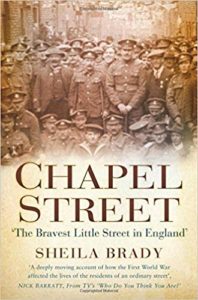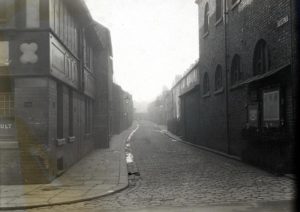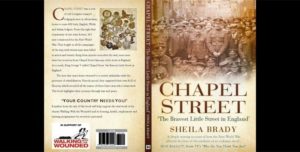Chapel Street “the Bravest Little Street in England” the History Press

As soon as you open this book you realise what a serious challenge this topic presents to an author. With few exceptions, any street in Britain would be able to tell stories about men who had marched off to join the Army or Navy in the early months and years of the Great War. Once in the “system” they would be dispersed to battalions and regiments across the Army, and to any one of the hundreds of ships in the Navy. So how does one begin to bring together and make sense of the diverse stories and experiences of those men throughout the War?
The answer has to be “with difficulty”. Sheila Brady is therefore to be commended for being brave enough even to attempt this task, especially when the numbers of men involved are so large. And, of course, this is the remarkable thing about Chapel Street. On the first day of the war, some 80 men signed up, with 161 eventually going into the Forces by the end of the conflict: and this from just 60 homes.
As the book explains, men were technically entitled to ask to be sent to a regiment of their choice, but it seems that the system was not fool-proof, and there might have been some discrimination against Irish regiments with a desire to disperse Irish ex-pats amongst other units and corps to avoid possible political leanings becoming a military problem at some later point. This is all the more relevant to Chapel Street given that so many of the inhabitants were of recent Irish descent, some being first generation migrants trying to escape so much deprivation and discrimination on the Island of Ireland.
To an extent, Sheila Brady majors on the Irish connection, with a summary of the evolution of the “Irish Question” by way of explanation as to why so many ended up in the North West of England. However, this should not detract from the fact that the English in that area were also extraordinarily quick to sign up. Indeed, up to end of the last century it was not uncommon for groups of solders from one small area of Manchester to end up serving in the same infantry company or tank-troop.
Back in the Great War the desire to maintain a sense of local comradeship led to the forming of the Pals Battalions, though the devastating effects on the local community were soon felt when whole battalions were almost wiped out in the bloody frontal assaults favoured at the time. The situation in Chapel Street was similar. Of the 161 men who went to war, some 29 died in action and another 25 or so from wounds and illness as a direct result of being at war. Three had been prisoners and returned in 1918. Many families in the street were therefore left without a bread-winner while others had to nurse men badly-injured both physically and mentally.
The book acknowledges that the final number of casualties and the true extent of misery inflicted on the street will never really be known as some of those living there were not properly “registered”, and others never went back, going to live elsewhere - perhaps returning to an Ireland that seemed closer to being given its independence. For example, the figures for POWs in one section indicates more than three were captured and held at one point.
Stylistically, the book is not “lightweight reading”. This is more of a scholarly digest of wartime accounts of battles and operations, drawing upon battalion and regimental war diaries as well as other contemporary material. As such, it is a book that one can usefully dip-into and learn much about local events and timelines. It might be hard to simply pick up and read through, whilst retaining a sense of a continuous story about the Street per-se. That would be an almost impossible thing to achieve for all the reasons mentioned above.

As with so many books of this sort, one criticism is the lack of maps and supporting images. For example, mention is made of old photographs of Chester and even Chapel Street; it would have been very interesting and a good “scene-setter” to have seen some of these. Similarly, a few maps of the operations being described would have been very helpful: those provided for section on the Gallipoli Campaign would perhaps have been a good model to have followed. That said, it is accepted that it would not have been possible to do so for each and every attack or defence mentioned in the book, and imagery does drive up publishing costs.
It is also somewhat frustrating that there is no actual list of those who served (a transcript of the Roll of Honour perhaps), and no index of names linked to known actions to allow relatives and descendants to try to discover more about the men and what they might have done. Perhaps in a future edition these might be included.
Some recent comments indicate that the data Sheila has accessed might have been less than 100% accurate; a few families have commented that they have personal records that contradict those in the book. However, this is almost bound to be the case and it is the sort of book that could turn into a major tome at some point as it attracts supporting comment and corrections to update data held in archives and official records offices.
One other aspect of the War that is perhaps not covered in sufficient detail is the extent to which the families, often in dire financial straits, managed to keep going without the husbands and sons. Were the women able to find new work in the armaments and equipment factories that sprang up at the time? Was there any form of social support or child care provide for them? Fascinating questions that might be topics for a follow-on book by Sheila Brady perhaps?
In summary, Chapel Street is a very brave initiative and much more of a “scholarly read” than had been anticipated, with some fascinating details emerging from the descriptions of some small-scale actions. The contextual information was good – again with some useful comments on aspects of the war that will be of interest to all. The main theme of the book, the sense of duty and sacrifice made by the men of Chapel Street, comes through by dint of the sheer number of accounts of what they were involved in.
It is also a worthy legacy to the bravery of Sheila’s great-uncle who was awarded the Military Medal for bravery after saving a wounded officer’s life in the Great War. It is for men like him that we should read books like this to remember what they sacrificed for us.

Chapel Street is well worth buying and studying, and particularly so given its links to Walking With the Wounded to which royalties from the sale of the book will be given.

Comments on Book Review: Chapel Street by Sheila Brady
There is 1 comment on Book Review: Chapel Street by Sheila Brady
Comment by Barbara Collett
My Mother in Law was born on chapel street. Her father and grandad are on the front cover. Her maiden name was Margiotta. She is 92years old. I hope this will be helpful to you. Barbara Collett.
Handpicked links